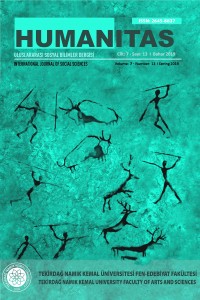Abstract
Keywords
References
- Barish, A., Hagood, C. (2012). Heteroglossic sprees and murderous viewpoints in Orhan Pamuk's ‘My Name Is Red. Texas Studies in Literature and Language, 54 (4), 505– 529.
- Benedict, A. (2006). Imagined communities: reflections on the origin and spread of nationalism. London; New York: Verso.
- Erdağ, G. (2006). Orhan Pamuk and the ‘Ottoman’ theme. World Literature Today, 80 (6), 34–38.
- Erdağ, G. (2012). Secular blasphemies: Orhan Pamuk and the Turkish novel. Novel: A Forum on Fiction, 45 (2) 301–326.
- Jose, C. (2011). The secular, secularizations, secularisms. In Rethinking secularism. Calhoun, Craig J, Mark Juergensmeyer, and Jonathan VanAntwerpen. Oxford, N.Y.: Oxford University Press.
- Mirze, E., Pamuk, O. (2008). Implementing disform: an interview with Orhan Pamuk. PMLA, 123 (1) 176–180.
- Orhan, P. (1998). Benim adım kırmızı. İstanbul: İletişim Yayınları.
- Patricia, W. (1984). Metafiction: the theory and practice of self-conscious fiction. London; New York: Methuen. .
Abstract
In his My Name is Red, Pamuk's clever use of metafiction shows that the novel responds to problems of plurality, inclusivity, and exclusivism concerning the theoretical debates on belonging, identity, and secularism in the nation-state. In the present study, we first show that the novel's statement is expressed via the inherent plurality of the narrative, achieved through constantly shifting perceptions and the use of several unexpected narrators in the novel. Second, we find such a pluralist use of metafiction quite significant, because the novel not only gives voice to the underrepresented, but also because Pamuk's metafiction offers an alternative and more plural, inclusive and democratic understanding of self-reflexivity. Metafiction in Pamuk's sense can make meaningful contributions to theory and its capacity to better understand modern, cosmopolitan and multicultural nations.
Keywords
art representation metafiction novel secularism nation-sate modern
References
- Barish, A., Hagood, C. (2012). Heteroglossic sprees and murderous viewpoints in Orhan Pamuk's ‘My Name Is Red. Texas Studies in Literature and Language, 54 (4), 505– 529.
- Benedict, A. (2006). Imagined communities: reflections on the origin and spread of nationalism. London; New York: Verso.
- Erdağ, G. (2006). Orhan Pamuk and the ‘Ottoman’ theme. World Literature Today, 80 (6), 34–38.
- Erdağ, G. (2012). Secular blasphemies: Orhan Pamuk and the Turkish novel. Novel: A Forum on Fiction, 45 (2) 301–326.
- Jose, C. (2011). The secular, secularizations, secularisms. In Rethinking secularism. Calhoun, Craig J, Mark Juergensmeyer, and Jonathan VanAntwerpen. Oxford, N.Y.: Oxford University Press.
- Mirze, E., Pamuk, O. (2008). Implementing disform: an interview with Orhan Pamuk. PMLA, 123 (1) 176–180.
- Orhan, P. (1998). Benim adım kırmızı. İstanbul: İletişim Yayınları.
- Patricia, W. (1984). Metafiction: the theory and practice of self-conscious fiction. London; New York: Methuen. .
Details
| Primary Language | English |
|---|---|
| Journal Section | Tüm Sayı |
| Authors | |
| Publication Date | March 22, 2019 |
| Published in Issue | Year 2019 Volume: 7 Issue: 13 |









